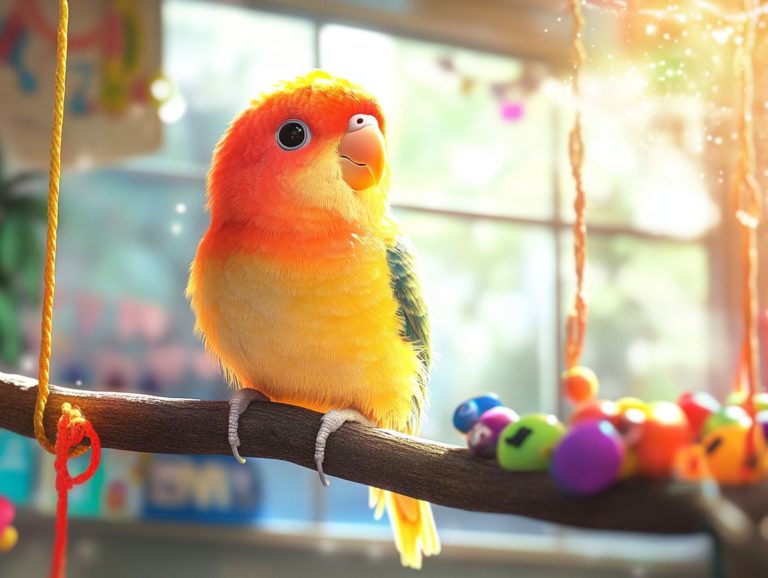How to Start a Bird Rescue?
Bird rescues protect and rehabilitate injured or abandoned birds. Starting a bird rescue can be incredibly rewarding!
Discover how you can create a sanctuary for birds in need!
Contents
- Key Takeaways:
- Why Start a Bird Rescue?
- Steps to Starting a Bird Rescue
- Managing a Bird Rescue
- Providing Care for Rescued Birds
- Finding Homes for Rescued Birds
- Frequently Asked Questions
- What is a bird rescue and how do I start one?
- Do I need any special skills or training to start a bird rescue?
- What are some common challenges when starting a bird rescue?
- How can I raise funds to support my bird rescue?
- How can I ensure the safety and well-being of the birds in my rescue?
- What are some best practices for running a successful bird rescue?
Key Takeaways:

- Starting a bird rescue can help birds in need and make a positive impact on your community.
- A strong plan and the right permits are key to running a bird rescue.
- Providing proper care, including nutrition and medical attention, is crucial for the well-being of rescued birds.
What is a Bird Rescue?
A bird rescue is an organization dedicated to the rehabilitation, care, and adoption of injured, abandoned, or neglected birds, especially parrots. These organizations prioritize animal welfare through rescue efforts and educational programs that foster a deeper understanding of bird needs.
Commonly rescued birds include finches, canaries, and raptors. This showcases the diverse array of species needing assistance. The rehabilitation process involves medical care, nutritional support, and a safe environment, which are crucial steps before birds can be placed into foster care or adopted.
Local organizations work tirelessly to ensure that each bird receives the emotional support needed during recovery. Your involvement is essential! Can you imagine the difference you can make? This contributes to a broader conservation initiative, raising awareness about habitat protection and the importance of preserving bird species for future generations.
Why Start a Bird Rescue?
Starting a bird rescue can significantly impact both the rescued birds and the community, fostering appreciation for animal welfare.
By addressing the emotional needs of birds through rehabilitation, you re offering them a second chance. You’re also inspiring a culture of community action focused on creating bird-friendly environments.
These initiatives serve as sanctuaries for displaced birds while educating the public on the importance of bird conservation and environmental stewardship.
Your efforts can spark a transformative movement that elevates the role of birds in our ecosystem and community!
The Importance of Bird Rescue Organizations
Bird rescue organizations address the needs of injured and abandoned birds. They provide essential services like healthcare assessments, rehabilitation, and a streamlined adoption process, promoting animal welfare and education within the community.
They cultivate partnerships with veterinary professionals to ensure both urgent and long-term health care needs are met efficiently.
Their ongoing fundraisers strengthen operations, covering medical expenses and investing in behavior training to help rescued birds navigate emotional challenges.
Through community education initiatives, they raise awareness about the unique needs of avian species and nurture a compassionate understanding among potential adopters. This increases the chances for sustainable placements and creates healthier environments for these remarkable birds.
Steps to Starting a Bird Rescue
Launching a bird rescue demands meticulous planning and a profound understanding of how to take care of birds. Additionally, exploring volunteer opportunities at local bird rescues can provide valuable insights. You need thorough research on the specific bird species you aim to rescue, secure the necessary permits and licenses, and craft a comprehensive business plan.
This groundwork ensures your rescue is sustainable and meets animal welfare regulations. Each of these steps sets the stage for a successful rescue operation and fosters a strong focus on rehabilitation and active community engagement.
Research and Planning
Research and planning are the cornerstones of a successful bird rescue. You ll need a deep understanding of bird habitats, animal behavior, and the specific needs of the birds you aim to rescue, such as parrots. This stage helps pinpoint environmental factors and devise an effective strategy for rehabilitation and conservation.
Explore community action initiatives and educational resources focused on avian conservation to gather comprehensive information about local bird species and their habitats. Engage with local wildlife organizations, join birdwatching groups, or attend workshops for invaluable insights into the challenges birds face, including habitat loss and the threat of invasive species.
Understanding these dynamics will help craft a targeted approach and foster community support and awareness, making your rescue efforts more sustainable and impactful. Stay informed about research studies and citizen science projects to learn about trends and encourage collective responsibility toward protecting these magnificent creatures.
Obtaining Necessary Permits and Licenses

Obtaining the necessary permits and licenses is crucial for establishing your bird rescue. This ensures compliance with local, state, and federal regulations related to animal shelters and conservation efforts. This process legitimizes your organization, builds trust within the community, and supports vital animal welfare initiatives.
Different species require specific permits, especially for endangered or migratory birds. These requirements can vary significantly based on your geographical location.
Navigating this complex landscape can feel overwhelming, so tap into community resources. Local wildlife organizations and conservation groups often offer valuable guidance. Forming partnerships with veterinary clinics can enhance your animal care capabilities.
These veterinary collaborations are essential for ensuring rescued birds receive the medical attention they need, reinforcing your rescue’s commitment to rehabilitating and nurturing these precious creatures.
Creating a Business Plan
Your business plan is your roadmap to success! Include strong financial strategies for operating costs, effective fundraising approaches, and long-term goals for funding animal rescue efforts. A well-structured plan helps manage daily operations and sets the stage for future community outreach and support.
Incorporating projected expenses is vital, allowing you to estimate the overall budget for ongoing bird care. Identifying diverse funding sources enables your organization to remain operational without relying on one income stream. Develop strategies for community involvement, such as engaging locals through public programming, to raise awareness and foster a sense of ownership among residents.
Implementing ongoing fundraisers can create a sustainable revenue flow, ensuring the long-term viability of your rescue efforts and reinforcing your organization s commitment to avian welfare.
Managing a Bird Rescue
Effectively managing a bird rescue demands a complete approach that incorporates staffing, volunteer coordination, and the establishment of sustainable practices methods that help protect the environment over the long term. This strategy is essential for ensuring the well-being of the rescued birds and the overall efficiency of the organization.
You must be deeply committed to animal welfare and nurturing a supportive community network. This commitment can profoundly impact the success of the rescue.
Staffing and Volunteer Management
Effective staffing and volunteer management are crucial to the success of your bird rescue. Focus on recruiting individuals who are genuinely passionate about animal welfare and understand the emotional support needs of the birds. Train your volunteers in animal behavior and care practices to create a safe and productive environment for both staff and rescued birds.
Consider implementing education programs and community education initiatives to inform the public about the challenges these species face and inspire potential volunteers to get involved. By fostering a positive work culture that values feedback and celebrates achievements, your volunteers will feel appreciated and more connected to the cause.
Working with birds can be an emotional rollercoaster. Balancing the highs of successful rescues with the lows of loss can be challenging. Providing ongoing support through mentorship and training programs offers volunteers opportunities to gain skills and navigate these emotional ups and downs. This ultimately leads to greater retention and satisfaction.
Fundraising and Budgeting
Fundraising and budgeting are essential elements in managing a bird rescue, as securing adequate funding is crucial for supporting operations, veterinary care, and rehabilitation services. By nurturing community involvement and organizing regular fundraisers, you can establish a sustainable financial model that guarantees the organization’s longevity.
To enhance your financial resources, explore a variety of diverse fundraising strategies:
- Charity walks
- Auctions
- Family-friendly festivals
These events engage your local community while raising awareness about the mission of bird rescue. Applying for grants provides vital funding from wildlife and conservation organizations. Building partnerships with local businesses boosts public outreach and opens avenues for sponsorships and in-kind donations.
All these initiatives demand careful financial planning to ensure funds are utilized effectively, maximizing their impact on the lives of the birds in your care.
Creating a Sustainable Rescue Model
Creating a sustainable rescue model is crucial for your bird rescue to thrive in the long run. It requires a commitment to animal welfare and the clever use of community resources to lessen environmental impact. Achieve sustainability through careful resource management, strategic partnerships, and ongoing community engagement.
Incorporating practices like recycling materials and repurposing equipment conserves valuable resources and significantly reduces waste. Foster bird-friendly habitats with native plants and thoughtfully designed local landscapes to enhance biodiversity.
Engaging the public through workshops and outreach programs raises awareness about habitat restoration and the vital connection between communities and wildlife. By enabling individuals with knowledge and resources, the community can take meaningful steps toward conservation efforts, ensuring both the environment and local wildlife are preserved for future generations.
Join us in making a difference volunteer today!
Providing Care for Rescued Birds

Providing comprehensive care for rescued birds stands as the cornerstone of a successful bird rescue and bird-friendly communities. This includes meticulous attention to medical care, proper nutrition, suitable housing, and rehabilitation services finely tuned to the unique needs of each species.
By adopting this overall care, you not only safeguard the physical health of the rescued birds but also cater to their emotional and behavioral needs. This paves the way for successful adoptions, including placements in specialized parrot sanctuaries and other suitable environments. It ensures that each bird is truly ready for its new home!
Proper Nutrition and Housing
Proper nutrition and housing are crucial for the care of rescued birds, ensuring their health and overall well-being in a sanctuary setting. By providing species-specific diets and safe, enriching habitats, you not only meet animal welfare standards but also foster positive behavioral outcomes.
Understanding the unique dietary needs of various species is essential! Some birds may thrive on fat-rich seeds, while others may require a diet of fruits or specialized pellets. Clean water is equally paramount to keep them hydrated and support their body functions.
Creating a habitat that closely mirrors their natural environments can provide emotional support, reducing stress and encouraging natural behaviors. By incorporating elements like perches, hiding spots, and climbing structures, you can craft a sanctuary that nurtures not just their physical health but also offers psychological richness allowing the birds to adapt and thrive.
Medical Care and Rehabilitation
Medical care and rehabilitation are essential for the recovery of rescued birds. Addressing their healthcare needs includes regular veterinary check-ups, injury treatments, and behavioral rehabilitation.
By establishing strong partnerships with veterinary professionals, you enhance the effectiveness of medical care, ensuring that rescued birds receive the attention necessary for a successful recovery.
When you foster collaboration between veterinary experts, rehabilitation specialists, and behavioral professionals, a more comprehensive approach to animal care emerges! These partnerships are vital for developing customized treatment plans that focus on physical ailments and emotional support.
Understanding animal behavior is crucial. It enables you to identify stressors and implement effective interventions, ultimately promoting a holistic healing process. This model of care ensures that birds recuperate both physically and emotionally, equipping them for a smoother reintegration into their natural environments.
Finding Homes for Rescued Birds
Finding loving homes for rescued birds is our top priority! It requires thoughtful placement strategies and a comprehensive adoption process that prioritizes the well-being of both the birds and their potential adopters.
This meticulous process not only addresses the emotional needs of the birds but also cultivates a sense of responsible pet ownership within the community.
Adoption and Placement Strategies
Adoption strategies help rescued birds find loving, permanent homes. These homes should meet their emotional and behavioral needs.
To elevate these efforts, consider fostering community involvement through workshops and informational sessions. These events educate prospective bird owners and champion animal welfare. By encouraging conversations about the responsibilities of bird ownership, adopting agencies can cultivate a supportive environment where adopters feel enabled to give the best possible care.
Regular follow-ups can help ensure that both the birds and their new families thrive. Ongoing support for adopters reinforces a lasting commitment to the well-being of these feathered companions. Ultimately, these strategies aim to forge a strong bond between the birds and their new homes, emphasizing that adoption is not merely an event but a lifelong responsibility.
Frequently Asked Questions
What is a bird rescue and how do I start one?

A bird rescue is a non-profit that helps birds in need. To start one, research local laws, secure funding, and gather a team of volunteers. You can also learn how to support your local bird rescue efforts to make a greater impact.
Do I need any special skills or training to start a bird rescue?
While experience in bird care is helpful, it’s not a requirement. Having a team of dedicated individuals with knowledge is essential for the well-being of the birds.
What are some common challenges when starting a bird rescue?
Common challenges include securing funding, finding suitable facilities, and navigating legal regulations. Additionally, you may face challenges in finding qualified volunteers and gaining community support.
How can I raise funds to support my bird rescue?
There are many ways to raise funds for your bird rescue. Consider hosting fundraising events, applying for grants, and seeking donations from individuals and businesses. A clear and transparent budget plan can attract donors.
How can I ensure the safety and well-being of the birds in my rescue?
To ensure the safety and well-being of the birds, have a team of trained volunteers, adequate facilities, and a veterinarian on call. Following the right protocols for handling and caring for injured or sick birds is crucial.
What are some best practices for running a successful bird rescue?
Best practices include building a strong team of volunteers, maintaining open communication with donors and supporters, and regularly promoting your rescue’s mission and accomplishments. Following all legal and ethical guidelines for animal care is also essential.






